49ers QB Mac Jones A Prime Trade Candidate For 2026
With Brock Purdy set to return to the starting lineup for San Francisco this weekend, head coach Kyle Shanahan has made it clear that there is no quarterback controversy in the Bay Area. That’s not to say backup passer Mac Jones hasn’t proven himself to be extremely capable of competing for a starting job but more so that Purdy will get the benefit of the doubt as the incumbent starter prior to injury. 
On the contrary to any potential criticism of Jones’ performance over his eight games as QB1, the buzz around the NFL recently has focused on the new trajectory of Jones’ career as a result of his commendable stint as the starter in San Francisco. According to Ian Rapoport of NFL Network, in a league desperate for serviceable quarterbacks, Jones has established himself as one and “emerged as a prime trade candidate for 2026.”
After watching Purdy miss two games in 2024 and watching two different backup quarterbacks lose games as injury replacements, the 49ers committed to signing a higher-quality second arm in 2025. The team landed on Jones, giving him a two-year, $7MM deal with the potential to make up to $11.5MM.
He’s already added $500K from an incentive of playing at least 25 percent of the team’s offensive snaps and winning at least four regular season games as a starter. After eight starts, he may just trigger the second incentive requiring a 50 percent snap share and a playoff berth; both are very possible but not guaranteed at this moment. The two levels of incentives exist in the second year of his contract, as well, and if Jones does get traded to a team that names him the starter, he’ll have a good shot at hitting those marks again.
While the 49ers would certainly like to keep their strong QB2 option next year, his value as a trade asset may supersede any desires of keeping him. The Dolphins, Jets, Steelers, Browns, Saints, and perhaps even the Raiders and Cardinals all stand as teams that could be looking for a new starter in 2026. For a while, it seemed that the 2026 NFL Draft would be the saving grace for these teams, rich with young quarterback talent, but lately, evaluators have lost faith in the talent level of the draft-eligible passers in school now.
As a result, San Francisco may opt to capitalize on the value Jones has created for himself. Trading Jones would be mutually beneficial for the two parties as the team would be doing right by Jones, giving him an opportunity to start in the NFL, while getting a potentially valuable return in exchange.
For now, the focus in San Francisco is making sure Purdy is healthy and up to speed enough to assist the team on a second-half playoff push while also keeping Jones game-ready in case injuries force the team’s hand once again. If Jones continues to excel at executing the tasks set before him, though, he may just put himself — and the 49ers — in a strong bargaining position.
Trade Candidate: Christian Harris
Through his first three seasons with the Texans, Christian Harris totaled 26 starts. Now a pending free agent, the linebacker’s role has declined sharply in 2025, leading to questions about his future. 
Harris handled over 700 defensive snaps during each of first two seasons in the league. He remained a full-time starter for the 2024 campaign but was limited to just five combined regular and postseason games that year due to a calf injury. The former third-rounder then dealt with an ankle injury during the offseason, but he managed to return to full health in time for training camp.
That resulted in Harris playing in each of Houston’s first four games. During that span, however, the Alabama product saw a snap share of just 13% on defense, a massive drop compared to his other seasons. Harris was a healthy scratch in Week 5. Given his status as a player seemingly not in the team’s immediate plans – coupled with the fact he is attached to the final year of his rookie contract – ESPN’s Jeremy Fowler names Harris as a trade candidate.
Per Fowler, Harris is held in high regard by other teams. That could result in a market being generated with respect to trade interest, especially since he is 24. Harris is attached to a base salary of $3.41MM for 2025; an acquiring team would need to take on a prorated portion of that figure to close out the campaign. Any team willing to trade for him now (as opposed to a free agent pursuit) would presumably look into an extension as well.
After making a notable impact as a rookie, Harris set career highs in tackles (101), sacks (two) and pass deflections (seven) in 2023. Returning to that level of performance would be key in helping his market value, but it appears as though that will not be possible down the stretch if the rest of Houston’s linebacking corps remains healthy. The Texans have Azeez Al-Shaair, Henry To’oTo’o and free agent addition E.J. Speed in place, with each having handled a larger workload than Harris this season. Al-Shaair is under contract for next year, while To’oTo’o will be eligible for an extension this coming spring.
If those two remain key parts in the Texans’ plans for the second level of their defense, moving on from Harris before the November 4 deadline could be a sensible move. Sitting at 2-3 on the year, Houston will presumably avoid a seller’s stance if the team can continue the momentum generated over the past two weeks. Still, Harris will be a player to watch regarding a change of scenery if he continues to serve in a limited capacity leading up to the deadline.
Trade Candidate: Jaelan Phillips
While a lot of the focus in Miami right now is on the loss of star wideout Tyreek Hill, the attrition might not stop there. The trade market appears to be hungry for pass rushers, and the Dolphins may just be willing to open one up to the crowd in fifth-year outside linebacker Jaelan Phillips. 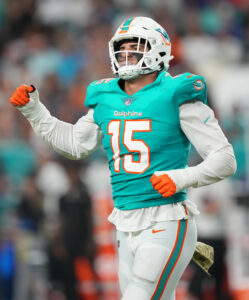
The team’s second first-round pick in 2021, Phillps didn’t have to go far after finishing out his collegiate career at The U. A five-star recruit out of Redlands East Valley HS in southern California, Phillips first committed to play at nearby UCLA. He made an immediate impact as a true freshman before seeing his sophomore season come to an early end after only four games because of a season-ending concussion.
After being dealt multiple other injuries, including some from being hit by a car while on a moped, Phillips followed advice to medically retire from the sport. After the school year ended, though, Phillips transferred to Miami (FL), where he intended to return to football. He sat out the 2019 season, as required by the NCAA transfer rules at that time, before delivering a second-team All-American season for the Hurricanes. He opted to forgo his eligibility and was drafted 18th overall by Miami.
Phillips came swinging out the gate for the Dolphins. Rotating in off the bench most of the time as a rookie, Phillips’ 8.5 sacks were a half-sack away from the team lead, which he did achieve with seven sacks in his sophomore campaign. Over those first two years, in addition to the 15.5 sacks, Phillips compiled 17 tackles for loss, 41 quarterback hits, three pass deflections, three fumble recoveries, and a forced fumble.
In 2023, Phillips looked to be on pace for career-defining year. After missing three of the team’s first five games, he went on a six-game tear. In eight games total, Phillips had racked up 6.5 sacks and seven tackles for loss. With six games left in the season, Phillips looked certain to achieve some new career highs. Instead, a torn Achilles tendon ended his season.
The Dolphins exercised Phillips’ fifth-year option, giving themselves a bit more time to see how he might recover and rejoin the team, and he worked hard to make his way back to the field in time for some training camp. He had overcome injury again and was ready to reap his reward. Unfortunately, Phillips’ injury troubles did not stay at bay for long. In just the fourth week of the 2024 season, Phillips suffered a partially torn ACL that would end that season, as well.
 After three and a half healthy seasons of high-level play, it seemed as if Phillips had beaten his injury demons, coming back from the brink of football retirement to become a first-round pick and an NFL starter. In the past two years, though, the medical red flags from his past have begun to stick again.
After three and a half healthy seasons of high-level play, it seemed as if Phillips had beaten his injury demons, coming back from the brink of football retirement to become a first-round pick and an NFL starter. In the past two years, though, the medical red flags from his past have begun to stick again.
Still, Phillips is healthy today. Once again working his way back to the field for the start of the regular season, Phillips has started every game so far for Miami and hasn’t appeared on a single injury report. He hasn’t amassed a sack, tackle for loss, or quarterback hit this year, but the Dolphins have been slow to work him back up to the volume of snaps he was playing back in 2022.
If a team is willing to give up some draft compensation for a partial-year rental of Phillips, it seems Miami would be more than willing to oblige. With Phillips on the final year of his contract, there’s a chance he could earn a lucrative deal in free agency if the team that trades for him doesn’t extend or re-sign him. If so, that team could potentially earn a compensatory pick for losing him.
The Dolphins, too, could just wait for the compensatory reward of letting Phillips walk in free agency, but according to Greg Auman of FOX Sports, Miami would prefer to get a pick for the 2026 NFL Draft now rather than wait for the comp pick in 2027. Plus, because of the comp pick potential, they can ask for a bit more in draft compensation, though it may be a wash as the team receiving him would be taking on more than half of the $13.25MM base salary he’s due this year on his fifth-year option.
So, what teams might be interested in acquiring the 26-year-old with a bit of an injury history? It would likely be a team that is struggling to get pressure on opposing quarterbacks, and knowing the short-term nature of his deal, they could be hoping to contend this year. The 49ers fit that bill, considering their 18 pressures are good for second-worst in the NFL, despite the fact that they are one of only two teams to have played five games this year. The Commanders, Chiefs, and Eagles are also playoff-hopeful teams who currently sport middle-of-the-road pass rush numbers.
Regardless, there may not be much of a future for Phillips in Miami. Even if he could work his way past a slow start and finish the season strong, his brutal injury history may dissuade a Dolphins front office that has already watched him miss a good portion of the last two seasons. Counterintuitively, a brighter future for Phillips may await him outside of Miami.
Trade Candidate: Darnell Washington
While the Jalen Ramsey–Minkah Fitzpatrick swap stole headlines earlier this week, the Steelers also added some major tight end depth in Jonnu Smith. It’s not hard to understand Pittsburgh’s thinking. As the team looks to load up around Aaron Rodgers, they added a savvy veteran who’s coming off a career year in Miami.
 [RELATED: Steelers Acquire, Extend TE Jonnu Smith]
[RELATED: Steelers Acquire, Extend TE Jonnu Smith]
When paired with incumbent Pat Freiermuth, the Steelers now have one of the strongest TE tandems in the entire NFL. However, the Smith acquisition pushed another notable tight end down the depth chart…and potentially off the roster altogether.
Darnell Washington is known more for his measurables than his actual NFL production, and for very good reason. At six-foot-seven, the Steelers tight end is one of the most physically intimidating individuals in the entire league. He doesn’t lead his position in height; that achievement belongs to teammate Donald Parham Jr., who is out for the upcoming season thanks to a torn Achilles. Unlike Parham and similar to fellow 6’7″ tight ends like Colby Parkinson and Tyree Jackson, Washington stands out on the scale, where he weighs in at 264 pounds.
Also unlike those other physical behemoths, Washington has actually shown some major athleticism. During the 2023 combine, the tight end recorded a 4.64-second 40-yard dash time. For comparison’s sake, Steelers rookie RB Kaleb Johnson recorded a 40-yard time of 4.57 seconds, and while 2025 first-round tight ends Colston Loveland and Tyler Warren didn’t participate in the dash, their estimated times came in lower than the Steelers TE (4.70 for Loveland, 4.68 for Warren).
Washington won a pair of National Championships during his time with the Bulldogs, and despite topping out at 454 receiving yards, the Steelers still snagged him with the 93rd-overall pick in the 2023 draft. Now known affectionally as “Mount Washington” in Pittsburgh, the tight end still hasn’t truly clicked on offense through his first two NFL seasons. After hauling in only seven catches as a rookie, the 23-year-old took a mini leap this past season, finishing with 19 receptions for 200 yards and one touchdown. Understandably, the Steelers have clearly been looking for a bit more.
That lack of production probably explains why the Steelers anxiously inked Smith to an extension following yesterday’s trade, and with Freiermuth also signed to a long-term deal, Washington appears destined to play out his rookie contract as the Steelers’ third tight end. Considering his draft status, Washington’s contract hardly breaks the bank ($1.46MM cap hit in 2025, $1.70MM cap hit in 2026), so the Steelers certainly won’t feel any urgency to trade him.
However, that also doesn’t mean other teams won’t come knocking. Washington’s incredible size and skills certainly makes him a worthy gamble, especially if a team is looking for a giant red zone target. If he doesn’t end up working out, a suitor could also consider moving him to the offensive line. There were rumblings that Washington may be destined for an offensive tackle role in the NFL, and Pro Football Focus handed him the sixth-highest run blocking score among TEs in 2024 (he finished 25th for pass blocking).
Sure, Washington isn’t the biggest name, and there will probably be bigger-name tight ends who shake loose over the next few months. Still, not every trade candidate is intended to drive jersey sales. For squads seeking some high-upside tight end depth, Washington certainly warrants consideration.
Trade Candidate: Allen Lazard
So far, Allen Lazard‘s career has been tied in lockstep with new Steelers quarterback Aaron Rodgers. Lazard spent his first five years in Green Bay catching passes from Rodgers. Then, in anticipation of a trade that would send Rodgers to the Jets, Lazard headed to New York as a free agent. With Rodgers now in Pittsburgh, there’s certainly a door open that could reunite Lazard with Rodgers, once again. 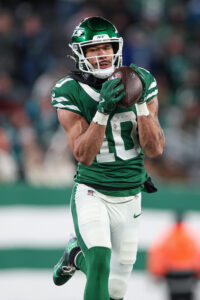
Originally signing with the Jaguars after going undrafted out of Iowa State in 2018, Lazard failed to make Jacksonville’s 53-man roster but signed to the team’s practice squad. Late in December of his rookie year, though, Green Bay signed him off the Jaguars’ p-squad as they saw a number of injuries to their own receiving corps. While he didn’t contribute much that season, he found his home of the next four years.
While Lazard was never a favorite target of Rodgers in Green Bay — a role rightly reserved for Davante Adams — he had a consistent role in the offense. In his second and third seasons, he contributed an average of 34 receptions for 464 yards and three touchdowns. He became more of a redzone target in 2021, logging 40 catches for 513 yards and a career-high eight touchdowns, before putting up a career year in 2022 with 60 catches, 788 yards, and six touchdowns.
Later rumors would indicate that following that final season in Green Bay, Lazard and Rodgers often spoke of playing in New York together. In fact, Lazard took the initiative to reach out to the Jets about the free agent deal he would eventually sign. Lazard’s first year in New York became essentially a wasted season, though, when Rodgers tore his Achilles tendon in the season opener. With Zach Wilson, Trevor Siemian, and Tim Boyle throwing to him, he only logged 23 receptions for 311 yards and a single touchdown. He improved last year, with Rodgers back on the field, but returned to his average totals with 37 catches for 530 yards and six touchdowns.
With Rodgers no longer in New York, Lazard’s current role seems uncertain. Adams departed from New York this offseason, seemingly giving Lazard a shot to be WR2. Unfortunately, according Rich Cimini of ESPN, Lazard is losing the WR2 battle to free agent addition Josh Reynolds. Per Cimini, Reynolds is the “clear-cut favorite” to land the job.
There was a time at which it seemed Lazard was certainly not long for New York. Early in the offseason, rumors came out that the Jets were likely to release him in the offseason, and a couple weeks later, the team gave him permission to seek a trade. Ultimately, the team opted to retain Lazard’s services, restructuring his contract to solidify the deal.
Despite this renewed commitment, Rodgers’ Pittsburgh signing immediately reignited rumors of a trade that would send Lazard to the Steelers. Given that cutting or trading Lazard before June 1 would’ve resulted in $6.55MM of dead money with him still taking up $1.94MM in cap space, it starts to make sense that Lazard has been kept around to this point, but a post-June 1 trade would now leave New York with only $2.18MM in dead money while relieving $2.43MM in cap space.
Cimini still thinks that it would be unlikely that the Jets would trade Lazard away. If they do, though — and Cimini notes here that that’s “a big if” — New York likely wouldn’t do so until the end of the preseason. The Jets have a lot of new pieces in their offense, and they’ll need to make sure they’re comfortable with their depth at wide receiver before agreeing to send Lazard away.
Trade Candidate: George Pickens
Having played out the first three seasons of his rookie contract, George Pickens is eligible for an extension. In spite of that fact – and his status as a potential 2026 free agent – his Steelers future remains a notable point of discussion and uncertainty. 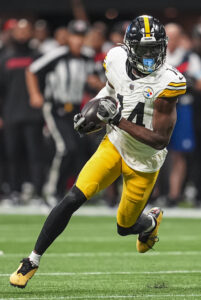
Entering the draft, Pickens was regarded as one of the most talented prospects at the receiver position. Character concerns played a role in his drop to the second round, but expectations remained relatively high for his rookie campaign. Serving as a No. 2 option to Diontae Johnson, Pickens posted 801 yards on an average of 15.4 per reception in 2022. During the following season he took over as Pittsburgh’s top option in the passing game, leading the league with an 18.1 yards per catch average and recording a 63-1,140-5 statline.
Johnson was traded away last offseason, but that move and the decision to release Allen Robinson left the Steelers short on established wideouts. Efforts to make a major addition by trade (in particular Brandon Aiyuk during the summer and Christian Kirk ahead of the deadline) did not result in a deal being made. Pickens therefore remained the top catalyst on offense for the Steelers, a unit which struggled mightily down the stretch. Part of Pittsburgh’s five-game losing streak (counting the wild-card round) to close out the campaign included Pickens’ missed time due to a hamstring injury, but even upon return he had an inconsistent showing.
While sorting out the quarterback position is an obvious priority for the Steelers this offseason, adding at the WR spot is another. Acquiring a new No. 1 option through free agency, trade or the draft would be challenging for general manager Omar Khan, but doing so could open the door to moving on from Pickens. As Mark Kaboly of the Pat McAfee Show notes, trading away the 23-year-old is an option the team may be prepared to explore if a major pickup were to be made this spring.
Calvin Austin III and Roman Wilson are recent midround receiver draftees, but further investment will be needed moving forward. As Kaboly adds, selecting a wideout in the first round of April’s draft would not come as a surprise; that would of course be particularly true if Pickens were to be dealt. Finding a suitor willing to acquire and extend the Georgia product could be difficult, though.
 Pickens is in line for a second contract any time between now and next offseason, and the top of the receiver market sits at $35MM per year. Matching Justin Jefferson’s compensation (or that which Ja’Marr Chase is in line to receive soon) would be a stretch, but Pickens could easily join the list of receivers (which currently sits at 23) making $20MM or more on average per year on an extension. He comfortably led Pittsburgh in receiving in 2024 and will be expected to continue as one of the league’s premier deep threats and contested catch specialists on the Steelers or another team moving forward.
Pickens is in line for a second contract any time between now and next offseason, and the top of the receiver market sits at $35MM per year. Matching Justin Jefferson’s compensation (or that which Ja’Marr Chase is in line to receive soon) would be a stretch, but Pickens could easily join the list of receivers (which currently sits at 23) making $20MM or more on average per year on an extension. He comfortably led Pittsburgh in receiving in 2024 and will be expected to continue as one of the league’s premier deep threats and contested catch specialists on the Steelers or another team moving forward.
Head coach Mike Tomlin – who will remain in place as Pittsburgh’s head coach for 2025 – has a reputation of maximizing the potential of wideouts carrying off-the-field and attitude concerns. That has been the case so far with Pickens, although earlier this year Tomlin admitted in a post-game press conference his team’s WR1 needs to “grow up.” The sentiment regarding Pickens around the league will (along with financial considerations) be a key factor in determining his potential trade market.
Of course, the Steelers have the option of keeping Pickens in place for at least one more season. A franchise tag could also be used to retain him for the 2026 season if no long-term commitment is made, although by that point it will be clearer if team and player wish to continue their relationship. Should the Steelers open extension talks in the near future, the likelihood of a trade would obviously decrease. In the event negotiations are put on hold or do not progress as planned, however, the possibility of making a deal will no doubt be raised in Pickens’ case.
Trade Candidate: Miles Sanders
Miles Sanders‘ future in Carolina was a talking point leading up to the campaign, and his situation still makes a departure something to watch closely for. The veteran running back is drawing trade interest as the Panthers contemplate offloading any number of contracts in the near future. 
Sanders is among the players who have been mentioned in trade talk, NFL Network’s Ian Rapoport reports. Carolina’s backfield already includes Chuba Hubbard, and second-round rookie Jonathon Brooks is close to being activated. The presence of those two threatens to make Sanders expendable. Indeed, Jordan Schultz of Fox Sports as well as ESPN’s Jeremy Fowler note the 27-year-old is believed to be on the trade block.
[RELATED: Panthers Not Planning To Trade Chuba Hubbard]
That comes as no surprise given the extent to which Sanders’ Panthers tenure has been a disappointment. The former Eagle had a career year in 2022, reaching a new personal watermark in yards (1,269) and touchdowns (11) en route to a Pro Bowl nod. Such production made him an attractive option on the open market, and he landed a four-year, $25.4MM pact with Carolina. That marked the largest running back investment of the 2022 offseason and led to high expectations for a strong showing in an undisputed lead back role.
However, Sanders averaged only 3.3 yards per carry in his debut Panthers campaign. He was overtaken by Hubbard on the depth chart, which led to speculation a change of scenery could be in store. It became clear right after the draft, however, that Carolina general manager Dan Morgan and head coach Dave Canales – neither of whom held those titles when Sanders was signed – intended to keep Sanders in place. The former third-rounder briefly faced the prospect of further backfield competition when Rashaad Penny was brought in, but the oft-injured veteran ultimately retired.
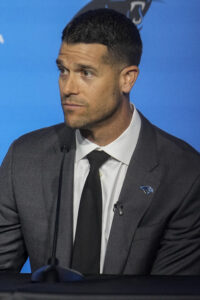 In spite of that development, along with Brooks starting the year on the NFI list, Sanders has logged only a 34% snap share in 2024. The Penn State product has turned 33 carries into 132 yards and one touchdown while adding 65 scoreless yards in the passing game. He is therefore on track for the least-productive season of his six-year career, something which will of course hinder his market value in the eyes of prospective suitors. On the other hand, Carolina has boasted one of the league’s worst offensive lines during Sanders’ time with the team, and an upgraded situation up front could spark a late-season rebound.
In spite of that development, along with Brooks starting the year on the NFI list, Sanders has logged only a 34% snap share in 2024. The Penn State product has turned 33 carries into 132 yards and one touchdown while adding 65 scoreless yards in the passing game. He is therefore on track for the least-productive season of his six-year career, something which will of course hinder his market value in the eyes of prospective suitors. On the other hand, Carolina has boasted one of the league’s worst offensive lines during Sanders’ time with the team, and an upgraded situation up front could spark a late-season rebound.
An acquiring team would be responsible for the remainder of Sanders’ $4.02MM base salary for this year, something which should be manageable for at least most teams eyeing backfield depth. He is due a $1MM roster bonus on the third day of the 2025 and ’26 league years, but none of his scheduled base salaries for those campaigns are guaranteed. As such, Sanders can be considered a rental or a player whose long-term outlook will depend on a restructure being worked out with his next team aimed at lowering his future cap hits ($8.18MM, then $6.98MM).
The running back position has stagnated in value compared to a number of other positions in recent years, although several veterans changed teams this spring on the open market. Sanders could soon be on the move via trade, and in that event he would have the opportunity to start over with a new team (although he would likely be intended as simply a rotational contributor, rather than a starter, on a contender). If not, the 1-6 Panthers will have a surplus at the running back spot once Brooks is activated.
Trade Candidate: Bailey Zappe
The Patriots completely revamped their QB depth chart this offseason, but there is still one holdover at the position. 2022 fourth-round pick Bailey Zappe is still kicking around at the bottom of New England’s roster, but it remains to be seen if the third-year pro will still be on the squad come September.
 Zappe has had an uneven two years in New England, although the Western Kentucky product hasn’t looked completely helpless in his handful of starts. During his rookie season, he sparked a brief QB controversy after guiding New England’s woeful offense to a pair of victories. However, Zappe slid back down the depth chart when Mac Jones returned from injury, and the Patriots were expected to continue with that same hierarchy for the 2023 campaign.
Zappe has had an uneven two years in New England, although the Western Kentucky product hasn’t looked completely helpless in his handful of starts. During his rookie season, he sparked a brief QB controversy after guiding New England’s woeful offense to a pair of victories. However, Zappe slid back down the depth chart when Mac Jones returned from injury, and the Patriots were expected to continue with that same hierarchy for the 2023 campaign.
Zappe ended up struggling under new offensive coordinator Bill O’Brien, leading to him being a surprise cut towards the end of the preseason. The second-year QB quickly landed on New England’s practice squad, and he was signed back to the active roster in early September. Still, the roster machinations proved that the Patriots were willing to let the player walk for nothing, and the apparent lack of interest from opposing squads proved their wasn’t a whole lot of league-wide intrigue in the signal-caller.
The backup QB managed to bounce back and (somewhat) rehabilitate his image during the 2023 campaign. With Jones and the Patriots offense continuing to struggle, Zappe ended up garnering six starts in New England. His numbers weren’t pretty (59.9 completion percentage, 2.8 touchdown percentage, 4.2 interception percentage), but he was notably under center for two of the team’s four wins. While nobody is confusing Zappe with a starting quarterback, the player at least proved that he wouldn’t compromise his team’s chances if inserted into the lineup.
With the Patriots navigating a post-Bill Belichick era this offseason, the organization decided to completely revamp their QB room. The team used the third-overall pick on Drake Maye, pairing the rookie with veteran acquisition (and old friend) Jacoby Brissett. The organization also used a sixth-round selection on Joe Milton III, a series of moves that seemed to push Zappe off the roster. Reports from earlier this offseason indicated that the Patriots wanted to resolve their QB jam as quickly as possibly, allowing the coaching staff to better evaluate their three sure-thing QBs. That could have led to a speedy cut for Zappe, but the QB is still sticking around the roster.
While the Patriots could claim that Zappe is competing with Milton for the QB3 role, there’s little chance the rebuilding squad will prefer the third-year player to the rookie. So, it seems more likely that the organization is holding on to Zappe until a QB-needy team comes knocking. Andrew Callahan of the Boston Herald indicated as much last month, noting that a Zappe trade remains a possibility for the organization. While teams didn’t show interest in Zappe last year, Callahan believes there could be a market for the player in the coming months, especially as teams face injuries during the preseason.
Callahan suggests that the Patriots could fetch a late-round pick in return for Zappe, or the front office could attach a pick to the QB for a better return. Considering the player’s track record, Zappe would probably be more appealing to teams that lose key backups vs. those that lose a starting QB. Of course, in order for the Patriots to avoid a staring match where a Zappe suitor simply awaits the player’s inevitable release, New England would require multiple trade partners to join the fray. Zappe’s most-recent deal with the Patriots keeps him under contract through the 2024 campaign on an easily-manageable $985K cap hit.
It seems like a foregone conclusion that Bailey Zappe won’t be sticking around New England for the 2024 campaign. However, it remains to be seen if the front office will be able to garner a return for the impending third-year QB.
Trade Candidate: Darius Slayton
The Giants offense has the potential to look extremely different in 2024 than they did in 2023. The starkest change obviously came with star running back Saquon Barkley heading to division-rival Philadelphia. The departures also included those of backup quarterback Tyrod Taylor and backup running back Matt Breida, and there’s a chance that the team is not nearly done seeing players walk out the door.
One possible additional departure could be veteran tight end Darren Waller. After injuries limited him in each of the past three years, Waller has been seriously contemplating retirement. While the team was hoping for an update by the draft, that deadline came and went with no decision. The most recent report claims that Waller will inform the team of his intentions by the time the Giants dismiss players for the summer break.
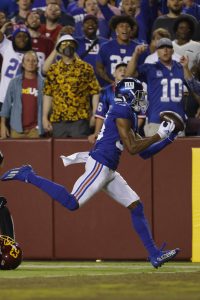 The other potential departure is a bit less cut-and-dried. The more mercurial situation is that of the contract of veteran wide receiver Darius Slayton. The 27-year-old wideout is heading into his sixth year of NFL play and the second year of the two-year, $12MM contract he signed last year to remain in New York. With another contract-year on the horizon, Slayton has been playing hardball in his attempts to attain his third NFL deal.
The other potential departure is a bit less cut-and-dried. The more mercurial situation is that of the contract of veteran wide receiver Darius Slayton. The 27-year-old wideout is heading into his sixth year of NFL play and the second year of the two-year, $12MM contract he signed last year to remain in New York. With another contract-year on the horizon, Slayton has been playing hardball in his attempts to attain his third NFL deal.
In April, Slayton made it clear that he was staying away from the first phase of offseason workouts for the Giants, taking a note out of Courtland Sutton‘s book in Denver. That strategy can only work for so long, though, as missing any of the team’s mandatory minicamp in June will result in fines. Giants general manager Joe Schoen denied at that time that the team was engaging in any extension conversations, but Slayton claimed that his agent, Michael Perrett, was in negotiations with Schoen following the draft.
Slayton has excelled in his role after being drafted in the fifth-round out of Auburn in 2019. He exploded onto the scene as a rookie, leading the team in receiving yards (740) and touchdown receptions (8). Since then, Slayton has led the Giants in receiving yards while surpassing 700 yards in every season except for one injury-limiting 2021 campaign. While impressive as a rookie, his inability to improve on those numbers has been limiting to New York’s offensive potential.
While leading the team is certainly an accomplishment, it may also be more a mark on the talent of the team’s receivers. He’s hardly ever the most-targeted player on the team and has twice been targeted fewer times than a running back or tight end. He’s put up impressive numbers for a fifth-round pick catching balls off the arm of Daniel Jones, but he hasn’t nearly put up solid, WR1 numbers.
The results of the draft may play a key role in Slayton’s future, as well. The Giants utilized their No. 6 overall draft pick on LSU wide receiver Malik Nabers, who many believe has the potential to be a true No. 1 wideout. Nabers also has the potential to add to a youth movement that could make Slayton superfluous. Last year saw second-year receiver Wan’Dale Robinson start to break out, and rookie third-round pick Jalin Hyatt began earning some starting snaps in the back half of the season. The two could pair up with Nabers to form a receiving corps that doesn’t need to depend on Slayton to lead the team anymore.
These three factors — Slayton’s hold out strategy, his limited top-end production, and the potential youth movement at receiver — could push the veteran out of New York altogether. The Giants have yet to show that extending Slayton is a priority, and continuing to add young talent to the position room shows that he is not likely to become one.
There are plenty of teams who could use a receiver who could be a strong WR2. As we pointed out in our profile on Titans wideout Treylon Burks earlier this weekend, the Bills and Chargers are paramount on that list after each team watched top receivers (Stefon Diggs–Gabriel Davis and Keenan Allen–Mike Williams, respectively) depart in some fashion. The Steelers, Jets, and Ravens all have some question marks on the roster at those positions, as well, but each team would likely be wary of giving away too much for Slayton.
That is another factor for whether or not Slayton finds himself on the trading block. He may not bring in a massive return for New York. Still, even for only a late-round pick or two, shipping Slayton off may be the cleanest way out of overpaying Slayton as a subpar WR1. The team’s top receiver since his arrival in 2019 is set to represent a $8.15MM cap hit in 2024. Trading him away could result in $6.4MM of cap savings.
Trade Candidate: Treylon Burks
Almost a year ago to this day, the Titans claimed they were “satisfied” with their group of wide receivers heading into the 2023 season. Two months later, the team decided to augment the group with the acquisition of veteran free agent DeAndre Hopkins. Still, the team finished 29th in the NFL in passing yards last year, leading to lots of investment in a new wide receiving corps. 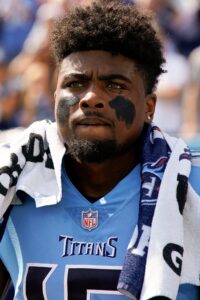
Hopkins did his job. In 17 games, he led the team in all receiving categories with 75 catches for 1,057 yards, and seven touchdowns. He didn’t have much help, though, as his 137 targets were more than three times higher than the next most-targeted wideout, Nick Westbrook-Ikhine (45), though tight end Chigoziem Okonkwo (77) and running back Tyjae Spears (70) received their fair share of targets.
The rest of the wide receiving corps provided nothing more than auxiliary numbers. After Hopkins, the next leading receivers were 30-year-old Chris Moore (22 receptions/424 yards/zero touchdowns), the undrafted Westbrook-Ihkine (28/370/3), and finally, former first-round pick Treylon Burks (16/221/0).
Burks experienced a bit of sophomore slump in 2023, even after putting up middling stats (33/444/1) in his rookie season. In both seasons, Burks has missed six contests with injury. His rookie year, turf toe landed him on injured reserve. This past season, an LCL sprain caused him to miss even more time.
Burks opportunity to turn things around in 2024 will be difficult in Tennessee. Though Moore has departed in free agency, Hopkins and Westbrook-Ikhine return next season. Additionally, the Titans invested massive capital in signing free agents Calvin Ridley and Tyler Boyd. Not only is this group a massive improvement over last year’s, but Hopkins also claims this is one of the best wide receiving corps he’s ever been a part of, per Michael David Smith of NBC Sports. That’s big praise for someone who shared the field with Larry Fitzgerald and Christian Kirk.
With Ridley, Hopkins, and Boyd manning the first-team offense and Westbrook-Ikhine showing more reliability in 2023 than Burks, the 24-year-old out of Arkansas will struggle to see much of the field this year. Even if he does get some snaps, he’s going to have to earn targets over those four, as well. It’s starting to seem that if Burks is going to turn things around, it will require a change of scenery.
Before last year’s trade deadline, the Titans made it clear that running back Derrick Henry and Hopkins were not available. They were more receptive to hearing offers on Burks but were not necessarily inclined to move a young, former Day 1 pick. One has to imagine that, with the additions of Ridley and Boyd, their stances may have changed.
Tennessee is likely not going to fetch a first-round value out of Burks like what Baltimore got out of Marquise Brown a couple years ago, but some teams may still see the potential value in acquiring the sixth receiver off the board in the 2022 NFL Draft. Even if they aren’t quite satisfied with the offers they receive for Burks, his value is likely only going to decline in 2024, barring a shocking breakout season.
As for teams with wide receiver needs following the draft and free agency, the Ravens, Bills, Chargers, Steelers, and Jets could all stand to take a swing. The Bills and Chargers probably house the biggest need. With Buffalo losing both Stefon Diggs and Gabriel Davis this offseason, Khalil Shakir, Curtis Samuel, and rookie second-round pick Keon Coleman lead their room. After losing star veterans Keenan Allen and Mike Williams, Los Angeles is depending on Josh Palmer, last year’s first-round pick Quentin Johnston, and second-round rookie Ladd McConkey in 2024.
The Steelers (George Pickens, Van Jefferson, Roman Wilson) and Jets (Garrett Wilson, Williams, Malachi Corley) are each relying on a dynamic, young talent, an intriguing free agent, and a third-round rookie, while Baltimore could be looking to add another pass catcher to replace Odell Beckham Jr.‘s production from last year.
The Titans should have some options if they feel the need to move Burks or if Burks feels the need to request a change of scenery. Either way, it’s hard to see a situation in which Burks finds tremendous success as WR4 or WR5 on a Tennessee offense quarterbacked by Will Levis. If Burks wants to turn his career around and if the team wants to maximize his value, a move might be necessary this offseason or before the next trade deadline.

